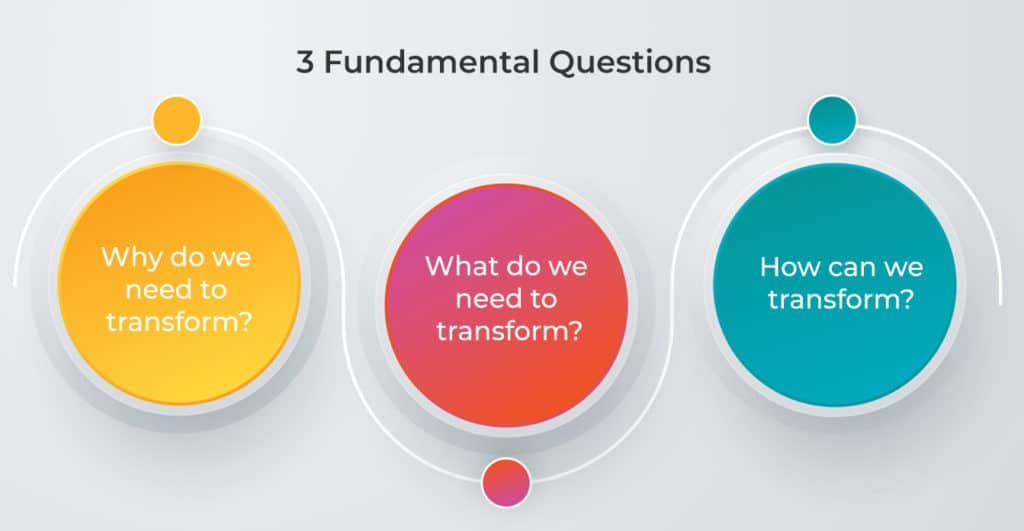With digital technologies growing and integrating into almost every business, digital transformation (DT) is no longer a choice, but a necessity. Following digital methods empowers your business as it allows you to challenge your status quo while coping with technological advancements efficiently, giving you a step ahead of the competition. Throughout this journey, some questions might pop into your mind, such as “How can I efficiently integrate digital technologies into every aspect of my business?”
What you need is a deep dive into what digital enablement really means and how your unique business model can successfully evolve with the least financial burdens. With this series of articles about DT, we are bringing you one step closer to achieving your business goals!
What does it mean to “digitally transform” your business?
Digital Transformation is an umbrella term that represents any organizational or operational changes that involve the integration of digital competencies; either to create new values or adapt to changing circumstances.
According to George Westerman, an MIT Sloan researcher who focuses on helping executives drive value from digital technology, the radical rethinking of how an organization uses technology, people, and processes to fundamentally change its business performance is the true core of what the “Digital Transformation” concept represents.
Why is DT an empowering strategy?
Integrating digital competencies offers companies the chance to unlock even more growth by allowing them to scale up appropriately, and reach new customers with minimal operating leverage.
What are the capabilities needed to engage in digital practices?

Adapted from LabVantage Solutions and edited by NP
First, your company shall be blessed with a Digital Savvy Management Team. Then, you need to create a transformative vision of how each part of the enterprise can be uplifted and by which digital approach. Now, you can engage employees in implementing your company’s vision by choosing the most relevant technologies. However, don’t forget to define the KPIs that should be tracked in order to ensure the effectiveness of the entire process.
The Right Strategy
The digital transformation journey needs a staged approach with a clear roadmap, involving a variety of end goals. That way, you can align your approach with your business goals as Bernie Gracy, Chief Digital Officer at Agero, explains “alignment is the most important step to a successful transformation”.
At this stage, there are THREE essential digital transformation strategy questions to ask:

Inspired from i-scoop
By answering these questions, CEOs and board members become ready to communicate that the move to digital is the right strategy and outline the right outcomes.
The Right Technology
While there are many recent technologies seeing rapid growth and adoption, it doesn’t necessarily mean you should implement all of them in your business. The choice of technology depends upon the process you are trying to optimize. Technology, as a matter of fact, is just a means to support your idea and sometimes execute it.
In general, technology adoption should be in line with the roadmap developed in the “right strategy”. Depending on organization priorities, whether that’s sales growth or operational efficiency, different companies will pick different digital solutions to fit their roadmap goals.

The Right Team
Ideally led by the CEO and other leaders in the organization, digital transformation requires cross-collaboration in pairing business-focused philosophies with rapid application development models.
For instance, to boost your company’s offline marketing; from brochures to online content, you shall gather up a team of a Marketing Strategist whose ultimate responsibility is deciding on and overseeing your digital promotion efforts, a Social Media Moderator that puts the Strategist’s plan into action, besides a Content Creator who will work closely with both your Strategist and Moderator to build up your online platforms. Finally, a Technical Supporter will be ahead to solve any issues in implementing the strategies needed.
As suggested by Small Business Trends, even if you can only bring on members of your digital transformation powerhouse team one at a time, keep these recommendations at the back of your mind. That way, you can address different needs, depending on your internal priorities and your budget.

The Right KPIs
How do you make sure that you are on track with what you have set for your company and whether your DT process is effectively achieving your business objectives?
You must be able to demonstrate the tangible business impact of this transformation to your executive work. Here are some important KPIs recommended by Members of Forbes Technology Council’s Article to measure your progress in this matter.
Revenue From New Digital Services
“Digital transformation is about creating revenue from new digital services; which means modernizing existing business applications. That is why the No. 1 digital transformation KPI should be the amount of revenue generated from new digital services.” – Carlos Melendez
Workforce Productivity
“Creating value by improving employee productivity through automation should be a priority. That is why Digital transformation can be tracked using revenue per employee to sum up in which direction the transformation is going.” – Ahmad Al Fares

Is there a noteworthy example? Yes, Nike Just Did It!
As stated by Gamelearn platform for corporate training, once the leaders of one of the world’s top athletic shoes and clothing company, Nike, felt like they were becoming sluggish and outdated, they didn’t hesitate. They applied a complete digital transformation framework to the company’s mindset, supply chain, and brand and were able to better connect with its customer base. The company focused on more powerful data analytics, updated its e-commerce strategy, created stronger digital marketing campaigns, and ramped up its Direct-to-Customer sales. With the efficient use of digital consumer data, Nike could open concept stores and improve the customer experience online.
But why go global, when we can focus on local examples that have successfully digitally transformed their businesses? Here’s Milkawy, for example, a local startup that has digitally transformed the milk collection process in Egypt.
Since the milk collection value chain in Egypt is paper-based, a lot of time and resources are usually wasted while tracking the entire process. Milkawy took the initiative and created a digital solution to put an end to this hassle. They developed 3 different apps that manage the collection process. The first allows the farmer to request a milk collector, the second is designed for the collector to receive the milk collection requests, and the third is designed specifically for the milk collection centers to handle the transaction between both parties.
This digital transformation has saved a lot of time, money, and effort for the farmers, collectors, and collection centers.
Where can you start your DT Journey?
You asked, we listened, Khalik Digital is an initiative by NilePreneurs that offers SMEs digital transformation solutions that help them reach their goals, increase their sales and strengthen their competitive advantage by appearing on new digital channels. So, when you find yourself in need of digital transformation consulting services, now you know where to look.
Still, wondering how your employees can adapt to the change? You can figure this out in the next article of our series, stay tuned!




